+ Open data
Open data
- Basic information
Basic information
| Entry | Database: PDB / ID: 3j1p | ||||||
|---|---|---|---|---|---|---|---|
| Title | Atomic model of rabbit hemorrhagic disease virus | ||||||
 Components Components | Major capsid protein VP60 | ||||||
 Keywords Keywords | VIRUS / icosahedral virus / calicivirus / lagovirus | ||||||
| Function / homology |  Function and homology information Function and homology informationribonucleoside triphosphate phosphatase activity / viral capsid / host cell cytoplasm / RNA helicase activity / cysteine-type endopeptidase activity / viral RNA genome replication / RNA-directed RNA polymerase activity / DNA-templated transcription / proteolysis / RNA binding ...ribonucleoside triphosphate phosphatase activity / viral capsid / host cell cytoplasm / RNA helicase activity / cysteine-type endopeptidase activity / viral RNA genome replication / RNA-directed RNA polymerase activity / DNA-templated transcription / proteolysis / RNA binding / ATP binding / membrane Similarity search - Function | ||||||
| Biological species |  Rabbit hemorrhagic disease virus Rabbit hemorrhagic disease virus | ||||||
| Method | ELECTRON MICROSCOPY / single particle reconstruction / cryo EM / Resolution: 6.5 Å | ||||||
 Authors Authors | Wang, X. / Liu, Y. / Sun, F. | ||||||
 Citation Citation |  Journal: PLoS Pathog / Year: 2013 Journal: PLoS Pathog / Year: 2013Title: Atomic model of rabbit hemorrhagic disease virus by cryo-electron microscopy and crystallography. Authors: Xue Wang / Fengting Xu / Jiasen Liu / Bingquan Gao / Yanxin Liu / Yujia Zhai / Jun Ma / Kai Zhang / Timothy S Baker / Klaus Schulten / Dong Zheng / Hai Pang / Fei Sun /  Abstract: Rabbit hemorrhagic disease, first described in China in 1984, causes hemorrhagic necrosis of the liver. Its etiological agent, rabbit hemorrhagic disease virus (RHDV), belongs to the Lagovirus genus ...Rabbit hemorrhagic disease, first described in China in 1984, causes hemorrhagic necrosis of the liver. Its etiological agent, rabbit hemorrhagic disease virus (RHDV), belongs to the Lagovirus genus in the family Caliciviridae. The detailed molecular structure of any lagovirus capsid has yet to be determined. Here, we report a cryo-electron microscopic (cryoEM) reconstruction of wild-type RHDV at 6.5 Å resolution and the crystal structures of the shell (S) and protruding (P) domains of its major capsid protein, VP60, each at 2.0 Å resolution. From these data we built a complete atomic model of the RHDV capsid. VP60 has a conserved S domain and a specific P2 sub-domain that differs from those found in other caliciviruses. As seen in the shell portion of the RHDV cryoEM map, which was resolved to ~5.5 Å, the N-terminal arm domain of VP60 folds back onto its cognate S domain. Sequence alignments of VP60 from six groups of RHDV isolates revealed seven regions of high variation that could be mapped onto the surface of the P2 sub-domain and suggested three putative pockets might be responsible for binding to histo-blood group antigens. A flexible loop in one of these regions was shown to interact with rabbit tissue cells and contains an important epitope for anti-RHDV antibody production. Our study provides a reliable, pseudo-atomic model of a Lagovirus and suggests a new candidate for an efficient vaccine that can be used to protect rabbits from RHDV infection. | ||||||
| History |
|
- Structure visualization
Structure visualization
| Movie |
 Movie viewer Movie viewer |
|---|---|
| Structure viewer | Molecule:  Molmil Molmil Jmol/JSmol Jmol/JSmol |
- Downloads & links
Downloads & links
- Download
Download
| PDBx/mmCIF format |  3j1p.cif.gz 3j1p.cif.gz | 264.3 KB | Display |  PDBx/mmCIF format PDBx/mmCIF format |
|---|---|---|---|---|
| PDB format |  pdb3j1p.ent.gz pdb3j1p.ent.gz | 204.8 KB | Display |  PDB format PDB format |
| PDBx/mmJSON format |  3j1p.json.gz 3j1p.json.gz | Tree view |  PDBx/mmJSON format PDBx/mmJSON format | |
| Others |  Other downloads Other downloads |
-Validation report
| Summary document |  3j1p_validation.pdf.gz 3j1p_validation.pdf.gz | 1.1 MB | Display |  wwPDB validaton report wwPDB validaton report |
|---|---|---|---|---|
| Full document |  3j1p_full_validation.pdf.gz 3j1p_full_validation.pdf.gz | 1.1 MB | Display | |
| Data in XML |  3j1p_validation.xml.gz 3j1p_validation.xml.gz | 51.6 KB | Display | |
| Data in CIF |  3j1p_validation.cif.gz 3j1p_validation.cif.gz | 76.7 KB | Display | |
| Arichive directory |  https://data.pdbj.org/pub/pdb/validation_reports/j1/3j1p https://data.pdbj.org/pub/pdb/validation_reports/j1/3j1p ftp://data.pdbj.org/pub/pdb/validation_reports/j1/3j1p ftp://data.pdbj.org/pub/pdb/validation_reports/j1/3j1p | HTTPS FTP |
-Related structure data
| Related structure data |  5410MC  4egtC  4ejrC M: map data used to model this data C: citing same article ( |
|---|---|
| Similar structure data |
- Links
Links
- Assembly
Assembly
| Deposited unit | 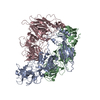
|
|---|---|
| 1 | x 60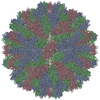
|
| 2 |
|
| 3 | x 5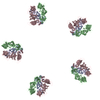
|
| 4 | x 6
|
| 5 | 
|
| Symmetry | Point symmetry: (Schoenflies symbol: I (icosahedral)) |
- Components
Components
| #1: Protein | Mass: 60376.770 Da / Num. of mol.: 3 / Fragment: UNP residues 1766-2344 / Source method: isolated from a natural source / Source: (natural)  Rabbit hemorrhagic disease virus / Strain: HYD / References: UniProt: F5BXG7 Rabbit hemorrhagic disease virus / Strain: HYD / References: UniProt: F5BXG7 |
|---|
-Experimental details
-Experiment
| Experiment | Method: ELECTRON MICROSCOPY |
|---|---|
| EM experiment | Aggregation state: PARTICLE / 3D reconstruction method: single particle reconstruction |
- Sample preparation
Sample preparation
| Component | Name: Wild Rabbit Hemorrhagic Disease Virus (strain HYD) / Type: VIRUS |
|---|---|
| Molecular weight | Value: 10.8 MDa / Experimental value: NO |
| Details of virus | Empty: NO / Enveloped: NO / Host category: VERTEBRATES / Isolate: STRAIN / Type: VIRION |
| Natural host | Organism: Oryctolagus cuniculus |
| Buffer solution | Name: TNE buffer / pH: 7 / Details: 50 mM Tris, 50 mM NaCl, 5 mM EDTA |
| Specimen | Embedding applied: NO / Shadowing applied: NO / Staining applied: NO / Vitrification applied: YES / Details: 50 mM Tris, 50 mM NaCl, 5 mM EDTA |
| Specimen support | Details: 200 mesh copper grid with holey array carbon support (GiG), glow discharged |
| Vitrification | Instrument: FEI VITROBOT MARK IV / Cryogen name: ETHANE / Temp: 100 K / Humidity: 100 % Details: Blot for 3 seconds before plunging into liquid ethane. Method: Blot for 3 seconds before plunging |
- Electron microscopy imaging
Electron microscopy imaging
| Experimental equipment |  Model: Titan Krios / Image courtesy: FEI Company |
|---|---|
| Microscopy | Model: FEI TITAN KRIOS / Date: Jan 22, 2011 |
| Electron gun | Electron source:  FIELD EMISSION GUN / Accelerating voltage: 300 kV / Illumination mode: FLOOD BEAM / Electron beam tilt params: 0 FIELD EMISSION GUN / Accelerating voltage: 300 kV / Illumination mode: FLOOD BEAM / Electron beam tilt params: 0 |
| Electron lens | Mode: BRIGHT FIELD / Nominal magnification: 96000 X / Calibrated magnification: 160770 X / Nominal defocus max: 2500 nm / Nominal defocus min: 1500 nm / Cs: 2.7 mm Astigmatism: Objective lens astigmatism was corrected at 100,000 times magnification Camera length: 0 mm |
| Specimen holder | Specimen holder model: OTHER / Specimen holder type: Liquid nitrogen cooled / Temperature: 85 K / Tilt angle max: 0 ° / Tilt angle min: 0 ° |
| Image recording | Electron dose: 20 e/Å2 / Film or detector model: GATAN ULTRASCAN 4000 (4k x 4k) |
| Radiation | Protocol: SINGLE WAVELENGTH / Monochromatic (M) / Laue (L): M / Scattering type: x-ray |
| Radiation wavelength | Relative weight: 1 |
- Processing
Processing
| EM software |
| ||||||||||||||||||||
|---|---|---|---|---|---|---|---|---|---|---|---|---|---|---|---|---|---|---|---|---|---|
| CTF correction | Details: CTF correction of each whole micrograph | ||||||||||||||||||||
| Symmetry | Point symmetry: I (icosahedral) | ||||||||||||||||||||
| 3D reconstruction | Method: Projection matching and Fourier reconstruction / Resolution: 6.5 Å / Resolution method: FSC 0.5 CUT-OFF / Num. of particles: 26000 / Nominal pixel size: 0.933 Å / Actual pixel size: 0.933 Å / Magnification calibration: cross gating and interpolation Details: The final map was sharpened to 4.5 Angstrom with B factor -300 and then filtered to 5.0 Angstrom (details about the particle: the particles were selected using an automatic selection program FindEM). Num. of class averages: 475 / Symmetry type: POINT | ||||||||||||||||||||
| Atomic model building |
| ||||||||||||||||||||
| Atomic model building | Pdb chain-ID: A / Source name: PDB / Type: experimental model
| ||||||||||||||||||||
| Refinement step | Cycle: LAST
|
 Movie
Movie Controller
Controller



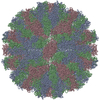
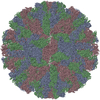
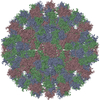


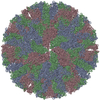
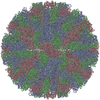


 PDBj
PDBj

